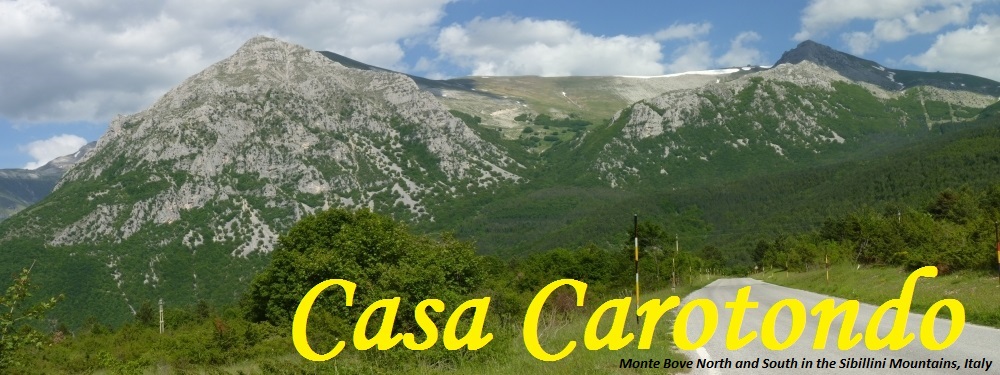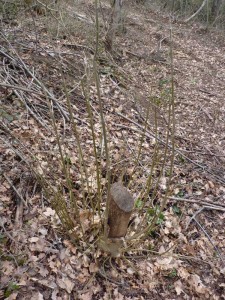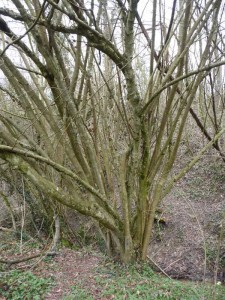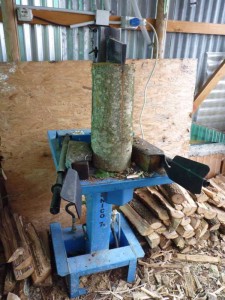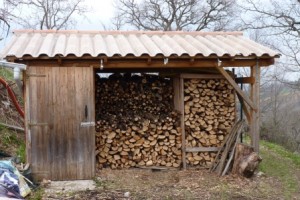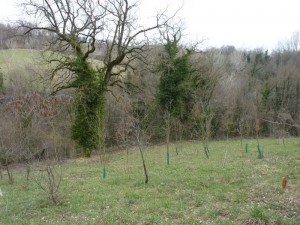Casa Carotondo has its own small wood. It was not something we had specifically wanted when looking for a house but while considering our move to Le Marche from London, we found out that gas in Italy is quite expensive. So we were pleased that we actually had our own source of fire wood. Chopping and preparing firewood is actually time-consuming and tiring work but somehow satisfying at the end of the process when you stand back and look at your full log store. It is a job that is generally carried out in early spring, when there are a thousand other things to do in the garden. We do have gas at Casa Carotondo but mostly for cooking or to heat the sanitary water on a cloudy summer’s day (we normally use solar panels to heat the water). Although some energy in the form of diesel and electricity is used to chop and transport the wood, on the whole it is a sustainable and cheap way to keep warm.
Generally it is best to choose a cool dry day to chop down trees as the required gear and the inevitable steep hillside make it hot work. Ideally the wood cutter should be equipped with a helmet, goggles, protective trousers and heavy duty steel capped boots. The chain saw for cutting down large trees is heavy and manipulating it on a steep slope requires care. Trees, when falling, often get stuck in their neighbour and have to be carefully pulled down with a rope. Sometimes the chainsaw blade gets stuck in the wood. There are all sorts of things that can go wrong.
Once cut the wood has to be collected. Again this is hard work requiring the wood to be carried or rolled from the point of cutting to a path where Rob can drive the tractor and trailer. The wood is then transported up to the tractor shed Rob built a few years ago, which now doubles as a wood processing shed. It means we can process the wood even on wet days and is away from the holiday apartments. We don’t want to disturb our guests with the high-pitched whine of the log splitter. Yes, we have a log splitter. It was expensive but worth the investment as it means weedy Vanessa can split logs while Rob gets on with the more heavy duty job of cutting the trees. The wood is split as soon as possible to help speed up the drying process. The split logs then have to be stacked in such a way that they stay as dry as possible but also get as much sunlight and air as possible.
Ideally wood should dry for two years before being used but so far we have always had to use the wood in the same year it is cut. It generally dries sufficiently but is not ideal and produces more tar residue on the wood burning stove than the really dry stuff. Our log store currently has a cement board roof with hindsight a polycarbonate roof that would allow the sunlight in would have been better. There are a number of things to consider when storing wood. You don’t want to transport it too often; this is labour intensive and uses fuel. It also needs to be near the house – you don’t want to be transporting wood long distances in the snow or heavy rain. It should also be located in a sunny spot to maximize the drying potential.
Our wood is not really large enough to sustain all our heating needs so in our first year here we bought 300 trees from the local forestry commission nursery. They were quite cheap. The bare rooted ones only cost 0.30 Euro each. However planting 300 trees was quite an ambitious project and we hadn’t really thought out the logistics of watering them in summer. Yes, they do need some water in July as it often doesn’t rain all month. Some of the trees died as a result of the lack of water, others were munched on by the deer. An investigation on the internet revealed that deer are particularly partial to ash. We, of course, had planted quite a few of these. Rob came up with the idea of covering them with leftover plastic piping. This seems to be working and they are slowly maturing. We have subsequently planted more trees but on a more modest level. The trees are slowly maturing but it will be a few years yet before it is worth chopping them down.
In the meantime we can supplement our wood stock with a locally sourced supply. This generally comes in 1 meter lengths and has to be further cut and split. Less time consuming, not so environmentally friendly and more expensive is the purchase of ready cut and split wood generally sourced from Eastern Europe. It is useful if you are pushed with renovation projects and don’t have time for major wood processing. Obviously not everyone is lucky enough to have a wood attached to their house or have the time and energy or even motivation to cut and chop wood. For us it is however a way of making a small contribution to combat global warming. Processing our heat source manually also makes us more aware of how much we use and how we can be more efficient in its use than if we simply flick a switch to turn on the gas. Although I must admit our last gas bill also had a similar effect!
